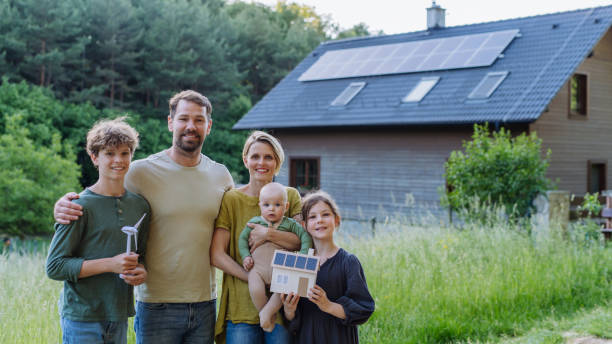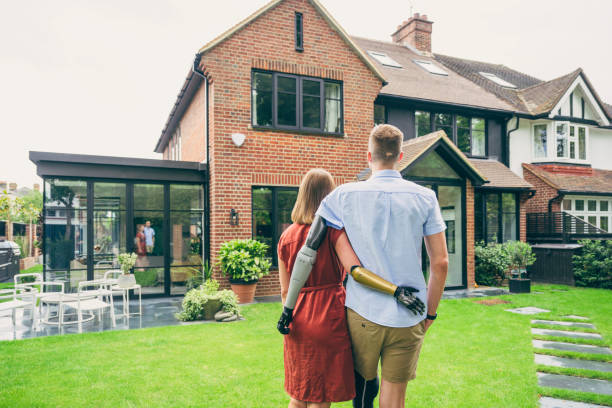As the world evolves rapidly, it is both possible and rewarding to create a sustainable house within our confines. We can reduce our environmental impact by combining smart technologies with sustainable practices to create a modern and eco house.
In addition to benefiting the environment, sustainable houses promote a healthy and sustainable lifestyle. This article will help you create a more environmentally conscious living space and reduce your ecological footprint.
Our goal will be to teach you how to transform space into a sustainable house by using practical tips and strategies. You can easily create a stylish and sustainable household that aligns with your values and supports a greener future by using sustainable house design and eco-friendly products.
What Sustainable Houses Are All About

Rather than being just a trend, sustainable houses have revolutionized the way we live. We are reshaping our environment every day with the decisions we make, starting with the spaces we occupy.
Sustainable house design is at the heart of the Green Revolution. It’s not only about adopting single eco-friendly models but also reimagining how our homes work to be environmentally friendly.
1. Sustainable House Design

An eco-house begins with a good design. From layout to materials, every decision you make can have a long-term effect. Sustainable building materials are a hallmark of eco-homes.
- Harness natural air
Airflow is a natural element that every homeowner must embrace. Reduce the need for artificial air and heating by strategically positioning windows.
It is also possible to reduce the need for air conditioning by strategically placing windows that allow natural cross-ventilation, thus ensuring a sustainable house for your family.
- Use natural light
To create a sustainable house, maximize natural light. Utilize light-colored window treatments and keep your windows unobstructed to allow ample sunlight into your living space. Your home’s mood and ambiance are enhanced by natural light, not only by reducing your need for artificial lighting.
To further improve your home’s energy efficiency, consider installing energy-efficient windows that minimize heat transfer and provide insulation.
- Invest in home insulation
You can save money on utilities and reduce your dependence on fossil fuels by insulating your home and preventing energy loss.
As an added benefit, insulation reduces noise levels in an eco-friendly household, making it more peaceful and tranquil. By reducing the amount of pollution emitted by your home, properly insulated houses reduce your carbon footprint.
- An energy-efficient building
Make use of the local climate to design energy-efficient architecture. In passive solar design, for example, solar energy is used to heat sustainable homes in the winter and shade them in the summer.
- Sustainable finishes
Making your home more sustainable can also be accomplished by choosing eco-friendly finishes. Bamboo, cork, and reclaimed wood are some examples of sustainable finishes.
Your home will not only look unique and stylish with these eco-friendly materials. A low-VOC finish is also an option, which is safer for your health and the environment.
- Furniture arrangement
It is also possible to make your home more sustainable by arranging your furniture. Make sure that your furniture is arranged in a way that maximizes the amount of natural light and airflow in your home.
As a result, you will be able to reduce your dependency on artificial lighting and air conditioning, as well as make your home more inviting and comfortable.
It may also be a good idea to consider furniture pieces that can be used for multiple purposes to save space and reduce the need to purchase additional items.
2. Energy-Efficient Systems

Energy conservation is a cornerstone of sustainable houses. Making your home more energy-efficient not only lowers your utility bills but also reduces your environmental footprint.
- Solar alternatives
Solar panels have been an integral part of eco-houses for decades. Using solar energy, you can generate clean and renewable electricity from the sun’s power. Solar panels are a green and renewable energy source that can help you reduce your carbon footprint in an eco-friendly household.
There may be a significant upfront investment, but the long-term benefits for your wallet and the environment are enormous. Additionally, solar panel rebates can make solar panels more affordable by offsetting the cost of installation.
As a result, solar panels are a great option if you want to make your home more environmentally friendly. To help you save even more money, you can also take advantage of QLD solar panel rebates for ecological homes!
- Smarter technology
We can manage our energy consumption more effectively thanks to modern technology. Temperatures are adjusted according to your preferences by smart thermostats, thereby optimizing energy efficiency. Also, you can turn lights on with automated lighting systems.
- Energy-saving appliances
Choose energy-efficient appliances when replacing your appliances with eco-friendly alternatives. Products that meet strict energy efficiency guidelines will have an Energy Star label. This ensures a reduction in the carbon emissions of your household because these appliances consume less energy.
3. Strategies for Reducing Waste

Sustainable houses should emphasize minimizing waste as one of its core tenets. We contribute to the global waste crisis through our consumption patterns, and reducing our waste is one way to transform our homes into eco-friendly havens.
- Making compost
To keep organic waste out of landfills, start a composting system. Sustainable gardening uses compost to enrich soil, reduce greenhouse gas emissions, and reduce greenhouse gas emissions.
Adding organic matter to your garden helps to lower landfill waste and fertilize it. Composting and recycling are also ways to save water and energy.
- Recycling center
Make sure your home has a designated recycling station. Make sure your household members are aware of how important it is to recycle materials.
New materials can be harvested or mined less frequently if you recycle your materials. The decomposition of food waste contributes to a reduction in methane emissions. A sustainable house therefore incorporates composting and recycling.
- Repurposing and upcycling
The outdated furniture in our attics and garages can be a perfect starting point for reusing and repairing old furniture, which is particularly great since retro and vintage furniture has been incorporated into every interior design trend over the past few years.
A little paint, some attractive materials, and a few tools will allow you to create stunning items that will surpass anything a store would sell.
As a result, you’ll also save some serious money compared to buying new furniture if you use the things you already own for new purposes. Besides that, you should separate your trash, recycle, and even create a recycling station to make the process easier.
There are more options than just paper and plastic bins, and you’ll become accustomed to these processes soon enough. It’s also possible to recycle cans and plastic bottles at recycling centers, which is always good news for the family’s budget.
4. Using water wisely

We are facing a global crisis of water scarcity. You can actively contribute to having a sustainable house by implementing water-wise practices.
Your home can become an eco-friendly haven by reducing water consumption. This not only conserves a precious resource but also lowers your energy bill and reduces the release of harmful chemicals into the environment.
Making water conservation a priority is one of the best ways to create a sustainable home, whether you install smart appliances that monitor your water usage or simply take measures to reduce unintentional waste.
- Flow-conserving fixtures
Make sure your toilets, showerheads, and faucets are low-flow. As a result of these fixtures, water usage is minimized and adequate water pressure is maintained, resulting in substantial water savings.
- Harvesting rainwater
You can harvest rainwater for gardening and landscape irrigation purposes that are not potable. To reduce the demand for municipal water supplies, rain barrels collect rainwater from rooftops.
- Xeriscaped landscape
Landscape practices such as xeriscaping are used in arid regions to reduce irrigation needs. Native, water-efficient plants are selected that are adapted to the local conditions.
5. Making Eco-Friendly Choices

In addition to making changes to your home, cultivate an eco-friendly way of life. Some choices you can make to ensure you have a sustainable house include:
- Conscious consumption
Choose sustainable brands and products with minimal packaging to practice conscious consumption. Spend your money on items that will last rather than cheap items.
- A plant-based lifestyle
Connect with nature and improve the air quality in your home by incorporating plants. The presence of indoor plants enhances your well-being by purifying the air naturally.
- Encourage others
Don’t limit the impact of the Green Revolution to your backyard. Encourage others to join the sustainable living movement by educating your community.
- Grow your food
Your home can become an eco-friendly haven if you start home agriculture. You can reduce your carbon footprint by growing your fruits, vegetables, and herbs instead of importing them.
Additionally, you can switch to organic growing methods by eliminating the use of pesticides. Your property will become a healthier ecosystem if you cultivate plants and gardens and improve soil health.
- Buy sustainable products
A sustainable product is designed with eco-friendliness in mind. These products are gentle on the earth and can help reduce your environmental footprint because they are made from natural materials, such as bamboo and wool.
Moreover, you can turn your home into a green oasis by replacing disposable paper towels with eco-friendly options.
- Clean with eco-friendly products
Your home can become an eco-friendly haven by using eco-cleaning products. You and your family can be exposed to fewer chemicals when you use these products.
In addition to preventing accidental damage, they are also gentler on surfaces and fabrics. By not throwing away unused cleaning supplies, you contribute to less waste overall. All in all, you and your family can be safer and more environmentally conscious in your home by switching to eco-cleaning products.
Key Stats on Sustainable Houses
- Across the last few years, building operations have consumed relatively little energy, according to the UN. As a result, CO2 emissions have increased by 9.95 gigatonnes since 2019
- A study estimates that up to 30% of the weight of building materials is wasted. Almost all of that waste is disposed of in landfills. Waste makes up more than 50% of total landfill volumes in the UK and 75% in the EU
- Up to 84 gigatons of CO2 emissions are expected to be reduced by sustainable architecture by 2025
- The energy consumption of sustainable buildings could be reduced by at least 50% by 2050
- The majority of building professionals expect to make their projects sustainable by 2021, with 47% expecting to do so in the upcoming years
- Approximately $99.8 billion will be spent on sustainable building in the US by 2023
- Australia emits 25% of its greenhouse gases from construction, building operation, and maintenance
- The USA could cut its energy consumption by around 27 to 59% if it implemented sustainable practices in around 30% of its buildings
Steps to Making Upgrades for a Sustainable House

To create a sustainable flow throughout your living space, you’ll need to make some changes in your home. As a first step, ensure everything you buy is sustainable from now on, and you’ll be able to spot new items like a pro once you’ve made a few initial purchases.
Start by taking a look at your house and identifying what needs improvement, repair, or replacement. There are eco-friendly products available that look just like products that aren’t sustainable, so you won’t have to sacrifice your interior aesthetics.
Introducing wood into your home and making it stylish and welcoming is made easy with new and trendy barn doors.
Conclusion
Sustainable living has become a vital necessity in the dynamic world of real estate. Real estate developers are increasingly conscious of the environmental impacts of their development, driving them to choose greener, eco-friendly options.
Creating a sustainable house is important for both the environment and your health. Assist others on the journey to a greener future by adopting these practices as a way of life. A more sustainable world can be created one eco-friendly home at a time when we work together.
FAQs
What do sustainable building materials mean?
In addition to using recycled wood, bamboo, and reclaimed materials, eco-friendly building materials use low-VOC paints with fewer harmful chemicals.
How can I have a sustainable house?
Earthship homes use sustainable practices to reduce their impact on the environment. The use of renewable materials, waste reduction, and energy efficiency improvements are included in this. The goal is to make conscious choices that benefit the planet and your household.
How can I make my sustainable house more energy-efficient?
The first step to minimizing heat loss and having a sustainable house is to upgrade your insulation. Use energy-efficient appliances, seal any drafts, and utilize natural light and ventilation to reduce your energy usage. Your utility bills will drop significantly over time as a result of these efforts.
What materials can I use for my sustainable house construction and renovation?
Eco-friendly building materials such as bamboo, reclaimed wood, recycled glass, and low-VOC (volatile organic compound) paints. These materials not only reduce the environmental impact of earthship home projects but also often contribute to healthier indoor air quality.
What are the benefits of solar panels in a sustainable house?
Solar panels are a fantastic addition to sustainable house design. They generate clean, renewable energy, significantly reducing your electricity bills.
Moreover, they decrease carbon emissions and can increase the overall value of your property. In some regions, you might even be eligible for government incentives or tax credits for installing solar panels.
How can I reduce water consumption in my sustainable house?
To reduce water consumption, consider installing low-flow fixtures in your bathroom and kitchen. Harvesting rainwater for outdoor use is also a smart approach.
Designing a water-efficient landscape with native plants that require less irrigation can further conserve water and promote a more sustainable environment.
Are there government incentives for sustainable house improvements?
Many governments offer incentives, tax credits, and rebates to encourage sustainable house improvements. These incentives often cover a range of projects, including solar panel installations and energy-efficient upgrades. Check with local and national authorities to discover what programs are available in your area for earthship homes.
What are ways to have a sustainable house on a budget?
There are several budget-friendly steps you can take to have a sustainable house. Start by replacing traditional light bulbs with energy-efficient LED lighting. Implement a recycling and composting system to reduce waste.
Reduce your use of single-use plastics by opting for reusable alternatives. These small changes not only reduce your environmental footprint but also save you money in the long run while contributing to a more sustainable lifestyle.







